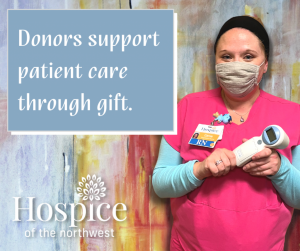Donors Provide Third Bladder Scanner
In mid-September, Hospice of the Northwest clinicians were thrilled to receive a third bladder scanner for patient visits. Bladder scanners are essentially tiny, portable ultrasound machines charged in the office and deployed with field staff as needed. Funded entirely by generous donors, these small devices make a tremendous impact on patient care.

Bladder scanners are a non-invasive tool for detecting how much volume is present in a patient’s bladder. When a large volume of liquid stays in the bladder for a period of time, the bladder becomes swollen. This is incredibly painful for patients, making it difficult to sit still or get comfortable.
“The beauty of this for hospice patients is that so many of our patients, as their disease progresses, aren’t able to tell us what is going on,” said Anita Meyer, MD, Medical Director for Hospice of the Northwest. “If we can identify that there is a lot of urine in the bladder, we can put a catheter in there to make them feel better.”
With hospice care, it can be very difficult to get definitive answers. There are limited tests that can be performed in a home setting and treating patients can often be based on a clinician’s best guess given the information provided by the patient or their family.
“With these bladder scanners, we can know definitively,” said Dr. Meyer. “That is such a blessing in hospice. Before we had these scanners, if we suspected this was bladder distention, we would have to put in a catheter to find out. These small machines save us from needing to put a patient through an invasive procedure to see if their bladder is empty.”
Hospice of the Northwest Foundation donors purchased two bladder scanners prior to this latest donation. The first two scanners were used so often, and the geographic region served is so large, it was difficult to get a bladder scanner from one end of the service area to another. This third scanner allows each field team to have their own machine, handing it off to regional team members more easily within their daily travels.
“This is a great example of how donors directly improve patient care,” said Dr. Meyer. “These scanners are expensive, and they are used every day. Donors are giving us the tools we need to do a great job with patients care.”